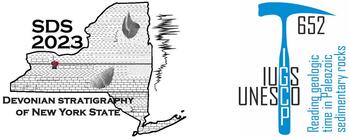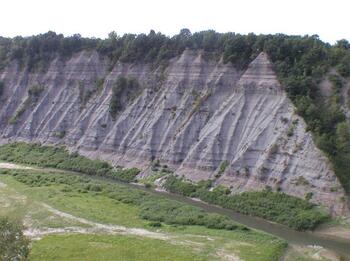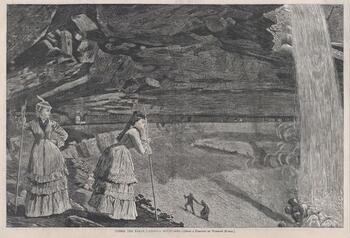SDS 2023 - Geneseo, New York - program and field guides

SDS 2023 and IGCP 652 - Annual Meeting
Geneseo, New York
26 July 2023 to 07 August 2023
New York State has been the focus of Devonian studies for over 200 years. 2018-2024 marks the 200th anniversary, or there about, of several publications by Amos Eaton (and Eaton and Beck) that described the geology of Albany County as well as the lands between the Susquehanna and Hudson rivers. It is fitting that the SDS recognize and celebrate this with a return to New York and the type Devonian of North America in 2023. Sessions will include Devonian climate evolution, paleoclimate and bioevents, time scale advances, and the Devonian sea level curve. Two field trips will visit the Upper Devonian geology of western New York and adjacent states (pre-meeting) and the Lower and Middle Devonian geology of the central and eastern part of the state (post-meeting).
Program and Abstracts
Registration
Pre-registration interest information form: SDS 2023.doc (287 KB)
Registration form and site: https://go.geneseo.edu/sds2023
Registration Deadline is 1 May 2023 - closed
Subcommission on Devonian Stratigraphy
The International Union of Geosciences (IUGS), amongst other tasks, features the International Commission on Stratigraphy (ICS), which is composed of individual subcommissions on individual systems and the Precambrian that build the formal, officially and internationally defined time units (chronostratigraphic units) of Earth History. The Subcommision on Devonian Stratigraphy has been one of the most active subcommissions of the ICS since it formed in 1973, which is mostly based on a highly successful integration of all leading specialists of Devonian stratigraphy, regardless of their specialization or their origin. SDS currently comprises three officers (chairman, vice-chairman, secretary/second vice chairman), 18 Titular Members, and ca. 80 Corresponding Members, covering all continents and all stratigraphic methods. http://devonian.stratigraphy.org/ - Official website of the Subcommission on Devonian Stratigraphy.
IGCP 652 Reading Geological Time in Sedimentary Rocks
The IGCP is a cooperative enterprise of the United Nations Educational, Scientific and Cultural Organization (UNESCO) and the International Union of Geological Sciences (IUGS) and has been stimulating comparative studies in the Earth Sciences since 1972. After three decades of successful work, the "International Geological Correlation Programme" continued as "International Geoscience Programme". Up to this day, IGCP has made research results available to a huge number of scientists around the world with about 400 projects.
The thesis of IGCP 652 is that major events punctuated the Paleozoic: such as ecological crises and diversifications, shifts in ocean chemistry, and climatic changes. One of the key obstacles in understanding these events is the difficulty of providing precise estimates of the duration represented by a sequence of Paleozoic sedimentary rocks. This lack of temporal precision severely hampers the evaluation of forcing mechanisms and rates of climatic, ecological, sedimentological, or biogeochemical changes. It is therefore essential to first improve the Paleozoic timescale to then unravel the history of the Paleozoic Earth system. Cyclostratigraphy is a powerful chronometer, based on the detection of the Milankovitch cycles in the sedimentary record. Those cycles result from periodic variations in the Earth-Sun system, affecting the distribution of solar energy over the planet influencing Earth’s climate on time scales between 104 and 106 k-years. Through the integration of this astronomical time scale with biostratigraphy and radio-isotopic dating, this project intends to document the environmental evolution during the Paleozoic with a focus on the Ordovician to Devonian (485 – 359 million years). It gathers participants (> 200) from all over the world (36 countries) and promotes the participation of young scientists and scientists from developing countries. http://www.geolsed.ulg.ac.be/IGCP_652/index.html - website of IGCP Project 652.
Business Meeting IGCP 652: 01 August 2023
Geneseo, New York
Geneseo - "sandy bank" in reference to the landings along the Genesee River - was founded in 1832 within the historic lands of the Tonawanda Band of the Seneca Nation of Indians in the western Finger Lakes of New York State. It is the seat of Livingston County and home of the State University of New York College at Geneseo. The National Historic Landmark village, population of 9,000, is in the heart of rich farm land sitting above the broad Genesee River Valley adjacent to Letchworth State Park that features a deep gorge cut into Upper Devonian strata. Toronto, Canada (3 hours), Buffalo, NY (1.2 hours), and Rochester, NY (40 minutes) are nearby metropolitan areas. In July and early August the average high temperature is 80 F (27 C) degrees and the low temperature is 60 F (16 C) degrees. It rains one in four days through the month.
http://FingerLakesWest.com - Livingston County area website.
https://geneseony.com/# - Geneseo village web site.
https://www.geneseo.edu/ - SUNY-Geneseo website.

Conference Goals and Topics
30 July (Sunday) to 01 August (Tuesday)
The conference will be held in the Integrated Science Building [Newton 204 (3) and ISC 144 (4)] on the campus of the State University of New York (SUNY) College at Geneseo. Geneseo Campus Map.doc (296.6 KB) The campus rests on upper Givetian strata of the Hamilton and Genesee groups. Sessions will include Devonian climate evolution, paleoclimate and bioevents, time scale advances, the Devonian sea level curve, as well as other Devonian topics. Conference registration, including banquet, is ~$250.
Evening 29 July – welcoming reception
30 July – technical sessions and business meetings
31 July – Field trip to Frasnian-Famennian boundary strata in northern Pennsylvania, or to Niagara Falls, NY - Cost (~$50) US, which includes transportation and lunch.
01 August – technical sessions
02 August - Conference field trip to Silurian-Devonian boundary, Middle Devonian strata, and Paleontological Research Institute in Ithaca, NY. Banquet "under the whale" at PRI. Transportation included, lodging in Ithaca, NY prior to post-meeting field trip or transportation to Rochester, NY. https://www.priweb.org/ - web site for the Paleontological Research Institute / Museum of the Earth in Ithaca, NY
Abstract form
Abstracts: oral or poster presentations, extended abstracts up to two pages, including figures. Abstract form: abstract template for SDS 2023 word.doc
Abstract deadline 1 May 2023 - closed.
Rocks of the Devonian System cover forty percent of the State of New York from the Hudson Valley westward to Lake Erie—the northern end of the Allegheny Plateau and the Catskill Mountains. The first geological feature reported was a petroleum spring, first mentioned by Jesuit missionaries in 1656 near Cuba; in 1755 Lewis Evans separated the Devonian terrane as a distinct region. Genuine geological exploration began with the settling of the central and western parts of the State after the Revolution, with the survey of the Hudson Valley by Samuel L. Mitchill in 1796. Observations by Larochefoucauld in 1795–1797 gave an initial indication of the character of the rocks in the western part of the State. In 1803 G.-F. G. Volney increased the understanding of the rock relations across the State and published the first geological map of the United States in color. Amos Eaton, whose work dominated the field from 1818 to 1836, worked out in more detail the succession of Devonian strata. - abridged and modified abstract from Wells (1963).
Pre-meeting field trip
26 July (Wed) to 29 July (Saturday) - Features will be the Devonian-Carboniferous boundary, clastic strata in northeastern Ohio and northwestern Pennsylvania, Upper Devonian offshore clastic-dominated strata in western New York that contain the Middlesex event, Rhinestreet event, Kellwasser bed equivalents, and the Frasnian-Famennian boundary. The trip will start in Cleveland, Ohio; transportation from Rochester or Geneseo will be an option. Cost is ~$550 US, which includes transportation from Cleveland to Geneseo, meals, lodging, and guidebook. Field trip participation is limited to the first 40 registrants. Pre-meeting guidebook.
Intra-meeting field trip
Field trip to Frasnian-Famennian boundary strata in northern Pennsylvania Guidebook - F-F northern PA; or Niagara Falls and Silurian strata, guidebook in five parts: Part 1 - Niagara Frontier; Part 2 - Silurian Ia; Part 2 - Silurian 1b; Part 3 - Silurian II - road log; Part 4 - Middle Devonian Ia; Part 4 - Middle Devonian Ib; Part 5 - Middle Devonian II – cost ~$50 US, which includes transportation and lunch.
Post-meeting field trip
02 August (Wednesday) to 06 August (Sunday) - Features will be the disconformable Devonian-Silurian contact in western New York, Middle Devonian reef, Middle Devonian black shales, platform clastic and carbonates through the Finger Lakes region, and then Lower and Middle Devonian carbonate- to siliciclastic-dominated to thick terrestrial strata in eastern New York State. The trip will start in Geneseo, New York, and finish in Catskill, New York, about 3 hours north of New York City. Transportation will be provided back to Geneseo or Rochester. Participants may also opt to be dropped off in Catskill or Albany where the bus or train services New York City. Cost is ~$800 US, which includes transportation from Geneseo to Catskill and return to Albany or Geneseo/Rochester on 07 August (Monday), meals, lodging, and guidebook. Field trip participation is limited to the first 40 registrants. Post-meeting Guidebook - part 1; Post-meeting Guidebook - part 2

Transportation to and from Geneseo
Geneseo is not easily reached by public transportation when the college is not in session. Air, rail, and bus services connect Toronto, Buffalo, Rochester, and New York City, but in the summer months only one bus runs daily to Geneseo from the Trailways Bus station on 188 Cumberland Street, Rochester, at 8:15 AM, arriving to 106 Main Street in Geneseo at 9:05 AM. The return run is at 5:45 PM, arriving in Rochester at 6:30 PM. https://bustickets.com/ - link for bus routes and tickets for Trailways in US. Other options include taxis - http://turbotaxigeneseo.com/ - website for Geneseo Turbo Taxi, Uber, and a shuttle organized by the conference from the Rochester Airport to Geneseo on 29 July for a nominal fee. Parking will be available on campus in Lot A and Lot C adjacent to the ISC Building, as well as Lot H and Lot U, which are on the periphery of the campus - Geneseo Campus Map.doc.
Lodging in Geneseo
There are numerous places in the village and neighboring communities to find lodging; rooms have been blocked at the Quality Inn - Geneseo, 4242 Lakeville Road, +1 585 243-0500. The closest area with numerous hotels outside Geneseo is Henrietta, a suburb of Rochester. https://geneseony.com/# - Geneseo village web site with links to lodging.
Dining in Geneseo
The campus dormitories and dining areas will be closed for the summer, with the exception of the coffee shop in the campus union. There are numerous eateries on Main Street adjacent to the Integrated Science Building. There are also several restaurants further east of the campus along US 20A, but these are at least a kilometer away: https://geneseony.com/# - Geneseo village web site with links to eateries.
Further information is listed on the pre-registration interest form.
Any questions should be directed to Jeff Over - over@geneseo.edu